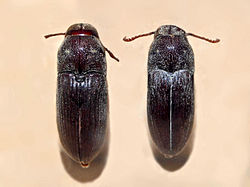Eucnemidae: Difference between revisions
Content deleted Content added
m Eucnemidae is a family thus does not need to be in italics |
→Subfamilies: subfamilies do not need to be in italics |
||
| Line 26: | Line 26: | ||
==Subfamilies== |
==Subfamilies== |
||
* |
* [[Anischiinae]] <small>Fleutiaux, 1936</small> |
||
* |
* [[Eucneminae]] <small>Eschscholtz, 1829</small> |
||
* |
* [[Macraulacinae]] <small>Fleutiaux, 1922</small> |
||
* |
* [[Melasinae]] <small>Leach, 1817</small> |
||
* |
* [[Palaeoxeninae]] <small>Muona, 1993 |
||
* |
* [[Perothopinae]] <small>Lacordaire, 1857</small> - perothopid beetles |
||
* |
* [[Phlegoninae]] <small>Muona, 1993</small> |
||
* |
* [[Phyllocerinae]] <small>Reitter, 1905</small> |
||
* |
* [[Pseudomeninae]] <small>Muona, 1993</small> |
||
==References== |
==References== |
||
Revision as of 21:59, 6 December 2016
| Eucnemidae | |
|---|---|

| |
| Euryostus reichei from New Guinea. Mounted specimen | |
| Scientific classification | |
| Kingdom: | |
| Phylum: | |
| Class: | |
| Order: | |
| Suborder: | |
| Infraorder: | |
| Superfamily: | |
| Family: | Eucnemidae
Eschscholtz, 1829 |
| Synonyms | |
| |
The Eucnemidae, false click beetles, are a family of polyphagan beetles including about 1700 species distributed worldwide.
Description
Closely related to the family Elateridae, specimens of Eucnemidae can reach a length of 2–30 mm (0.079–1.181 in). Bodies are slightly flattened and convex. The upper surfaces of the body usually has hairs, setae or scales.
Biology
Adults can usually be found in forests, on branches or under the bark of trees, especially in the abundance of dead wood. The larvae live in dead wood, but also in hard seasoned wood. Some species are soil-dwelling, living and feeding on the roots of dead trees.
Subfamilies
- Anischiinae Fleutiaux, 1936
- Eucneminae Eschscholtz, 1829
- Macraulacinae Fleutiaux, 1922
- Melasinae Leach, 1817
- Palaeoxeninae Muona, 1993
- Perothopinae Lacordaire, 1857 - perothopid beetles
- Phlegoninae Muona, 1993
- Phyllocerinae Reitter, 1905
- Pseudomeninae Muona, 1993
References
Wikispecies has information related to Eucnemidae.
Wikimedia Commons has media related to Eucnemidae.
- Biolib
- Discover Life
- J. F. Lawrence, A. M. Hastings, M. J. Dallwitz, T. A. Paine and E. J. Zurcher Elateriformia (Coleoptera)
- SYNOPSIS OF THE DESCRIBED COLEOPTERA OF THE WORLD
- Muona, J. 1993. Review of the phylogeny, classification and biology of the family Eucnemidae (Coleoptera). Entomologica Scandinavica, Supplement No. 44, 133 pp.
